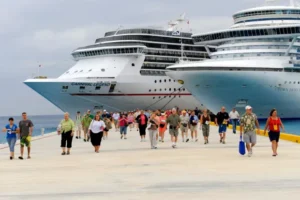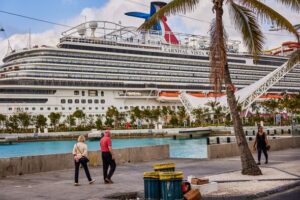Cruise Ship Passengers Must Pay Fee Upon Arriving in Mexico Starting July 1
Beginning July 1, 2025, cruise ship passengers arriving at ports in Mexico will be subject to a newly introduced entry fee, a move aimed at supporting local infrastructure and environmental initiatives. The policy, announced by Mexican authorities in coordination with the cruise industry, represents a shift in how the country manages tourism revenue in popular coastal destinations.
The new charge, officially referred to as the Derecho de No Residente (DNR) or Non-Resident Duty, starts at $5 per passenger in its first phase. The DNR applies to all foreign cruise ship passengers arriving at any Mexican port, including major destinations such as Cozumel, Puerto Vallarta, Cabo San Lucas, and Progreso. This fee will be collected directly by cruise lines and bundled into the fare, meaning passengers won’t need to make a separate payment upon arrival.
Gradual Fee Increases Through 2028
This initial $5 charge will not remain static. The DNR is designed to increase in stages over the next three years. According to the implementation schedule:

On August 1, 2026, the fee will rise to $10 per passenger.
On July 1, 2027, it will increase to $15.
Finally, on August 1, 2028, the fee will reach its peak of $21.
This staggered structure was developed after months of negotiations between the Mexican government and the Florida-Caribbean Cruise Association (FCCA), which represents many major cruise lines operating in the region. Originally, Mexican lawmakers proposed a flat $42 fee per passenger. However, cruise industry stakeholders voiced concerns that such a sharp fee could discourage bookings and harm tourism-dependent communities.
By negotiating a lower, phased fee, both sides reached a compromise that supports Mexico’s goals without placing undue burden on cruise operators or passengers.
Purpose of the Fee
Revenue from the DNR is earmarked for port infrastructure development, environmental conservation, and local economic investment. Mexico’s port cities have long been among the most visited cruise destinations in the Western Hemisphere, with Cozumel alone receiving millions of passengers annually.
Yet the high volume of tourism has strained local resources and ecosystems. Coastal erosion, coral reef damage, and waste management challenges are ongoing concerns in some port areas. The new funding is expected to help improve facilities, reduce environmental impact, and ensure that tourism growth remains sustainable.
The DNR fee model follows a broader trend seen in destinations worldwide that are seeking more direct financial contributions from visitors to help mitigate tourism’s side effects. Countries like Thailand, New Zealand, and various Caribbean islands have implemented similar visitor or environmental fees in recent years.
Who Is Affected?
The fee specifically applies to foreign cruise ship passengers who disembark at Mexican ports. It does not affect:
Travelers arriving by air or land.
Mexican nationals or residents.
Cruise passengers who remain onboard during port calls and do not step ashore.

The cruise lines will be responsible for collecting the fee and remitting it to Mexican authorities, simplifying the process for travelers.
Industry and Traveler Reactions
The cruise industry has reacted cautiously but positively to the final version of the fee policy. In a joint statement, the FCCA and several cruise lines expressed appreciation for Mexico’s willingness to engage in dialogue and reach a workable solution.
Many passengers, especially those who frequent Caribbean itineraries, are unlikely to notice the added cost immediately. When spread across the total cost of a cruise—often ranging from several hundred to several thousand dollars—a $5 to $21 fee is relatively minimal. However, as the fee increases over time, some cruise-goers may begin to weigh it more seriously when choosing itineraries.
Tourism officials in Mexico are hopeful the funds generated will make a noticeable impact on the quality of services and environmental conditions in popular port cities. Improvements may include upgraded port terminals, better transportation options for tourists, and enhanced conservation programs.
Looking Ahead
As the cruise industry continues to recover from the disruptions of the COVID-19 pandemic and navigates increasing pressures to operate more sustainably, passenger fees like the DNR could become a more common tool used by governments to balance tourism benefits with long-term planning.
Mexico’s phased approach reflects a growing awareness of both the value and the cost of mass tourism. If implemented effectively, the fee could serve as a model for other nations looking to sustain their tourism sectors without compromising environmental and community health.
For now, cruise passengers should be aware of the new fee and anticipate small adjustments to cruise fare pricing beginning with sailings arriving in Mexico on or after July 1, 2025.













